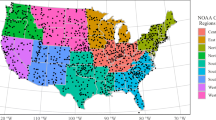Abstract
For the Tuvalu Island group in the western Pacific, a simple graphical method is proposed as a means of forecasting whether rainfall totals for the next 1, 2,…,6 months will be below average. The method is based on scatter plots where the points are color-coded as above- or below-average rainfall, with the plot axes being lag-1 and lag-2 NINO4 sea surface temperatures. Within the scatter plots there are reasonably clear data fields with higher frequencies of below-average rainfalls associated with cooler precursor NINO4 temperatures. These data fields are defined by subjectively emplaced separation lines which bifurcate the scatter plots into “predictable” and “unpredictable” fields. If two precursor NINO4 temperature values define a point located in a predictable field then a warning would be issued for below-average rainfall over the next n-month period, depending on the time scale of the scatter plot. A long rainfall record at Funafuti in Tuvalu indicates that success in predictable-field forecasting of below-average rainfalls would range between 68% for 1-month rainfall totals and 89% for 6-month totals. The forecasting success derives from persistence of cooler NINO4 sea surface temperatures which are associated with lower rainfalls in Tuvalu. However, many dry periods are also located in the unpredictable field and cannot be forecast by this method.






Similar content being viewed by others
References
Alory, G., and Delcroix, T., 1999, Climatic variability in the vicinity of Wallis, Futuna and Samoa islands (13°–15°S, 180°–170°W): Oceanol. Acta, v. 22, no. 3, p. 249–263.
Amador, J. A., Alfaro, E. J., Lizano, O. G., and Magan, V. O., 2006, Atmospheric forcing of the eastern tropical Pacific: a review: Prog. Oceanogr., v. 69, no. 2–4, p. 101–142.
Basher, R. E., and Zheng, X., 1998, Mapping rainfall fields and their ENSO variation in data-sparse tropical South-West Pacific Ocean region: J. Clim., v. 18, no. 3, p. 237–251.
Flohn, H., 1967, Dry Equatorial Zones and asymmetry, in Doberitz, R., Flohn, H., and Schütte, K., eds., Statistical Investigations of the Climatic Anomalies of the Equatorial Pacific: Meteorologisches Institut Der Universitat, Bonn, p. 3–8.
Folland, C. K., Renwick, J. A., Salinger, M. J., and Mullan, A. B., 2002, Relative influences of the Interdecadal Pacific Oscillation and ENSO on the South Pacific Convergence Zone: Geophys. Res. Lett., v. 29, no. 13, article 1643, doi:10.1029/2001GL014201.
Kurtzman, D., and Scanlon, B. R., 2007, El Niño-Southern Oscillation and Pacific Decadal Oscillation impacts on precipitation in the southern and central United States: evaluation of spatial distribution and predictions: Water Resour. Res., v. 43, no. W10427, doi:10.1029/2007WR005863.
Mishra, A. K., and Desai, V. R., 2006, Drought forecasting using feed-forward recursive neural network: Ecol. Modelling, v. 198, no. 1–2, p. 127–138.
Ruiz, J. E., Cordery, I., and Sharma, A., 2006, Impact of mid-Pacific Ocean thermocline on the prediction of Australian rainfall: J. Hydrol., v. 317, no. 1–2, p. 104–122.
Thompson, C. S., 1987, The climate and weather of Tuvalu: New Zealand Meteorological Service. Misc. Publication, v. 188, no. 6, 40 p.
Ueyama, R., and Deser, C., 2008, A climatology of diurnal and semidiurnal surface wind variations over the tropical Pacific Ocean based on the Tropical Atmosphere Ocean moored buoy array: J. Clim., v. 21, no. 4, p. 593–607.
Wyrtki, K., and Meyers, G., 1976, The trade wind field over the Pacific Ocean: J. Appl. Meteorol., v. 15, no. 7, p. 698–704.
Acknowledgment
The second author of this article was the recipient of funding from a NZAID scholarship.
Author information
Authors and Affiliations
Corresponding author
Rights and permissions
About this article
Cite this article
Bardsley, W.E., Vavae, H. A Simple Graphical Technique for Conditional Long Range Forecasting of Below-Average Rainfall Periods in the Tuvalu Islands, Western Pacific. Nat Resour Res 18, 277–283 (2009). https://doi.org/10.1007/s11053-009-9104-2
Received:
Accepted:
Published:
Issue Date:
DOI: https://doi.org/10.1007/s11053-009-9104-2




